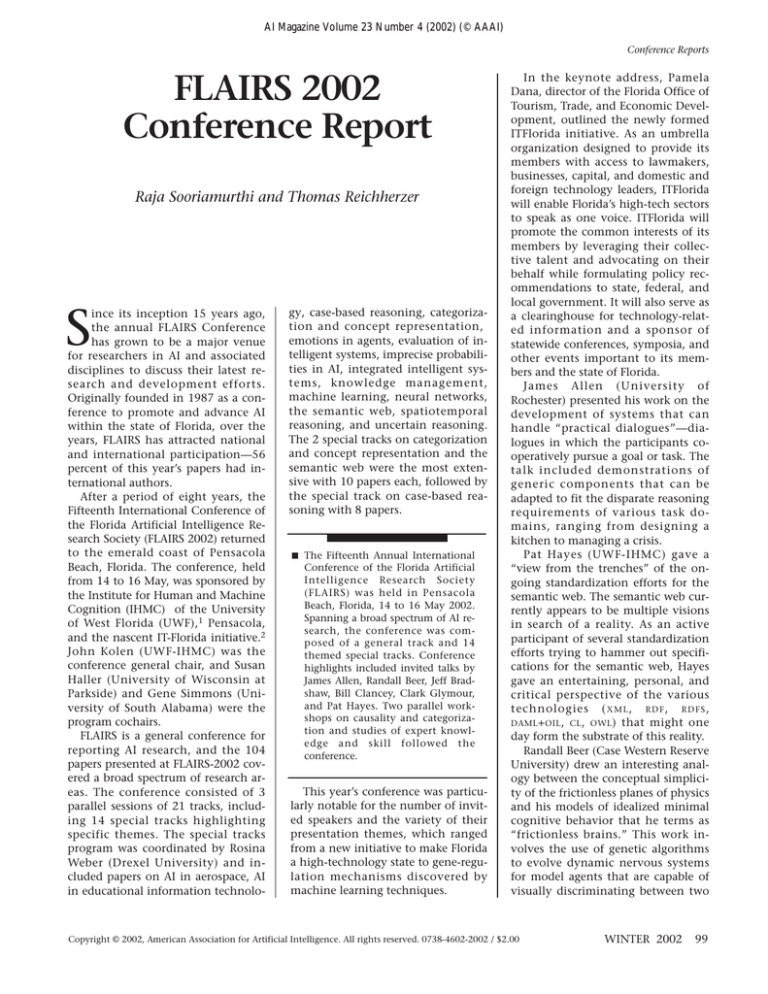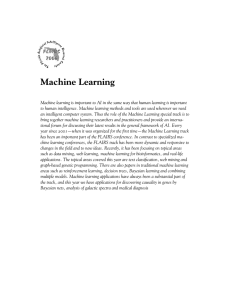
AI Magazine Volume 23 Number 4 (2002) (© AAAI)
Conference Reports
FLAIRS 2002
Conference Report
Raja Sooriamurthi and Thomas Reichherzer
S
ince its inception 15 years ago,
the annual FLAIRS Conference
has grown to be a major venue
for researchers in AI and associated
disciplines to discuss their latest research and development efforts.
Originally founded in 1987 as a conference to promote and advance AI
within the state of Florida, over the
years, FLAIRS has attracted national
and international participation—56
percent of this year’s papers had international authors.
After a period of eight years, the
Fifteenth International Conference of
the Florida Artificial Intelligence Research Society (FLAIRS 2002) returned
to the emerald coast of Pensacola
Beach, Florida. The conference, held
from 14 to 16 May, was sponsored by
the Institute for Human and Machine
Cognition (IHMC) of the University
of West Florida (UWF),1 Pensacola,
and the nascent IT-Florida initiative.2
John Kolen (UWF-IHMC) was the
conference general chair, and Susan
Haller (University of Wisconsin at
Parkside) and Gene Simmons (University of South Alabama) were the
program cochairs.
FLAIRS is a general conference for
reporting AI research, and the 104
papers presented at FLAIRS-2002 covered a broad spectrum of research areas. The conference consisted of 3
parallel sessions of 21 tracks, including 14 special tracks highlighting
specific themes. The special tracks
program was coordinated by Rosina
Weber (Drexel University) and included papers on AI in aerospace, AI
in educational information technolo-
gy, case-based reasoning, categorization and concept representation,
emotions in agents, evaluation of intelligent systems, imprecise probabilities in AI, integrated intelligent systems, knowledge management,
machine learning, neural networks,
the semantic web, spatiotemporal
reasoning, and uncertain reasoning.
The 2 special tracks on categorization
and concept representation and the
semantic web were the most extensive with 10 papers each, followed by
the special track on case-based reasoning with 8 papers.
■ The Fifteenth Annual International
Conference of the Florida Artificial
Intelligence Research Society
(FLAIRS) was held in Pensacola
Beach, Florida, 14 to 16 May 2002.
Spanning a broad spectrum of AI research, the conference was composed of a general track and 14
themed special tracks. Conference
highlights included invited talks by
James Allen, Randall Beer, Jeff Bradshaw, Bill Clancey, Clark Glymour,
and Pat Hayes. Two parallel workshops on causality and categorization and studies of expert knowledge and skill followed the
conference.
This year’s conference was particularly notable for the number of invited speakers and the variety of their
presentation themes, which ranged
from a new initiative to make Florida
a high-technology state to gene-regulation mechanisms discovered by
machine learning techniques.
In the keynote address, Pamela
Dana, director of the Florida Office of
Tourism, Trade, and Economic Development, outlined the newly formed
ITFlorida initiative. As an umbrella
organization designed to provide its
members with access to lawmakers,
businesses, capital, and domestic and
foreign technology leaders, ITFlorida
will enable Florida’s high-tech sectors
to speak as one voice. ITFlorida will
promote the common interests of its
members by leveraging their collective talent and advocating on their
behalf while formulating policy recommendations to state, federal, and
local government. It will also serve as
a clearinghouse for technology-related information and a sponsor of
statewide conferences, symposia, and
other events important to its members and the state of Florida.
James Allen (University of
Rochester) presented his work on the
development of systems that can
handle “practical dialogues”—dialogues in which the participants cooperatively pursue a goal or task. The
talk included demonstrations of
generic components that can be
adapted to fit the disparate reasoning
requirements of various task domains, ranging from designing a
kitchen to managing a crisis.
Pat Hayes (UWF-IHMC) gave a
“view from the trenches” of the ongoing standardization efforts for the
semantic web. The semantic web currently appears to be multiple visions
in search of a reality. As an active
participant of several standardization
efforts trying to hammer out specifications for the semantic web, Hayes
gave an entertaining, personal, and
critical perspective of the various
technologies ( X M L , R D F , R D F S ,
DAML + OIL , CL , OWL ) that might one
day form the substrate of this reality.
Randall Beer (Case Western Reserve
University) drew an interesting analogy between the conceptual simplicity of the frictionless planes of physics
and his models of idealized minimal
cognitive behavior that he terms as
“frictionless brains.” This work involves the use of genetic algorithms
to evolve dynamic nervous systems
for model agents that are capable of
visually discriminating between two
Copyright © 2002, American Association for Artificial Intelligence. All rights reserved. 0738-4602-2002 / $2.00
WINTER 2002
99
Conference Reports
This year’s conference was particularly notable for the
number of invited speakers and the variety of their
presentation themes….
types of objects. His talk concluded
with an analysis of the dynamics observed in the experiments with an explanatory and predictive insight into
the behavior of the evolved agents.
Jeff Bradshaw (UWF-IHMC) gave
an enticing glimpse of a possible future world populated with pervasive
agents functioning as “cognitive
prostheses” to leverage and extend
human intellectual, perceptual, and
collaborative capabilities. He described his current work in a joint
project with NASA/Ames on the design of a personal satellite assistant
(PSA)—a highly interactive autonomous softball-size robot functioning
in microgravity to assist astronauts
on spacecrafts.
Bill Clancey (NASA/Ames and
UWF-IHMC) gave a view of his intriguing work on the modeling of human activities. He described his experience at the Flashline Mars Arctic
Research Station—the first of four
Mars baselike habitats. Based on this
experience, Clancey discussed extensions to his prior research with
BRAHMS (a simulation program for
modeling work practices and generating work-flow diagrams) in modeling
and understanding human ensemble
100
AI MAGAZINE
behavior. One of the goals of this effort is to teach us how to live and
work on Mars.
Clark Glymour (Carnegie Mellon
University and UWF-IHMC) raised a
challenging question: Can we reveal
the mysteries of how life maintains
itself and responds to changes in the
environment? His stimulating and
entertaining presentation discussed
algorithms to extract causal networks
from gene microarray data and raised
questions on whether we will be able
to unlock the secrets of the millions
of gene-regulation mechanisms in
our cells in the near future.
Of the 104 papers presented at
FLAIRS-2002, 27 were part of the general conference track, and 78 focused
on the themed special tracks. From
the papers submitted to the general
conference track, the program committee recognized two outstanding
papers (which by coincidence happened to be in the same area of automated reasoning). The best paper
award went to Stephan Schulz of the
Technische Universitaet Muenchen,
Germany, for his paper entitled “A
Comparison of Different Techniques
for Grounding Near-Propositional
CNF Formulae.” The second award
was given to Marius Pasca of Language Computer Corporation for his
paper entitled “Answer Finding Guided by Question Semantic Constraints.”
The main conference was followed
by workshops on causality and categorization and studies of expert
knowledge and skill. The Workshop
on Causality and Categorization, organized by Clark Glymour and Colette Faucher (Universite d’Aix-Marseille III), focused on the role of
causal knowledge in the acquisition,
representation, and use of concepts.
The Workshop on Studies of Expert
Knowledge and Skill, organized by
Robert Hoffman (UWF-IHMC), pro-
vided a forum for applied cognitive
psychologists at Florida universities
to discuss their current research interests and explore the possibility of creating an innovative cooperative program of research and graduate
training.
For next year, FLAIRS will move
from the second-oldest continuously
inhabited city in the United
States—Pensacola—to the oldest continuously inhabited city: FLAIRS2003 will be held 11 to 15 May at St.
Augustine, Florida. Douglas Dankel
(University of Florida) will be the
general chair, and Susan Haller (University of Wisconsin at Parkside) and
Ingrid Russell (University of Hartford)
will be the program chairs. Further
details will be available from the
FLAIRS web site. 3 The FLAIRS proceedings is available from AAAI
Press.4
Notes
1. www.coginst.uwf.edu.
2. www.itflorida.com.
3. www.flairs.com.
4. www.aaai.org/Press/Proceedings/FLAIRS.
Raja Sooriamurthi is an
assistant professor of information systems at
the Kelley School of
Business, Indiana University at Bloomington.
His e-mail address is raja@indiana.edu.
Thomas Reichherzer
was previously a research associate at the
University of West Florida-Institute for Human
and Machine Cognition
and is currently a doctoral student in the
Computer Science Department at Indiana University. His e-mail
address is treichhe@cs.indiana.edu.



